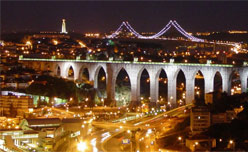Driving in Lisbon – learn from the locals
Lisbon is well-known for its quite remarkable mix of old and new, and this does not only apply to architecture.
Some narrow streets of Lisbon date back to before the 16th century where as others are quite modern results of additional funding when Portugal entered the European Union.
Others again are typical of the grand planning by the famous Marquês de Pombal after the 1755 earthquake. The planning of the avenues and enormous squares of the by then much smaller Lisbon took inspiration from the metropolis of Paris.
Old and new Lisbon are inter-connected by a web of streets. You will learn to know them as Travessa’s, Rua’s and Avenida’s.
Sometimes, the overall plan seems to have been lost, but that is part of the charm of the streets of good old Lisbon.
Finding your way in Lisbon – ask the locals
Often the Portuguese themselves lose their bearings in the capital, and asking somebody for direction is very common indeed.
This may be an effective way of getting to your destination, but unfortunately it can also lead you on a ‘wild goose chase’.
As much as the ‘Lisboetas’ want to help tourists, few of them are willing to admit if they don’t know the way to your destination. Surely, they will do their best, but most will simply let you know what they think is the right direction – possibly without knowing the way themselves.
The Portuguese drivers appear to know this and will ask for directions, drive a bit, ask again, drive a bit, ask again etc. etc.
If you have a map at hand, you are more likely to get qualified help for directions when driving in Lisbon.
Using GPS and navigation systems in Lisbon
A GPS is a powerful tool, but only to the extent that roads have been entered into the memory of the GPS database.
If you have a slightly dated GPS in your car, don’t expect it to be able to find every destination in Lisbon for you. The majority of hand held GPS units are rather good, although most of them will have no clue about a certain street when you try to find it from time to time.
The often, long winded and complicated, street names of Lisbon do not make this exercise any easier. Best advise is to use the coordinates of your destination if available on your GPS when driving in Lisbon.
Beware of passengers from trams in Lisbon
In the city of Lisbon, it is essential for drivers of cars to pay a lot of attention to trams and their passengers.
Often there are platforms for tram passengers to exit on, but not always. Drivers must yield to disembarking passengers from a tram.
Traffic jams and ‘close encounters’
The traffic in Lisbon can be quite a challenge and as the number of cars is increasing rapidly, the distance between vehicles on the streets sometimes becomes very small.
If you are not used to lining up 5-10 centimetres from the next vehicle or having motorbikes and scooters wearing in and out between cars, this can be somewhat nerve-breaking. The Lisboetas are used to this and takes it in its stride.
A lot of Portuguese vehicles are 10-25 years old and by the looks of some of them, they have been involved in more than their fair share of bumps and minor accidents.
If you plan to drive a lot in Lisbon, better take out additional excess insurance for your rental car, as the likelihood of a scratch or a smashed headlight or indicator is relatively high.
Most tourist in a hire car survive the encounter with Lisbon traffic without damages. However, because of the immense number of cars, bad sign postings, slightly erratic Portuguese driving (mind you, from a foreign point of view that is) and bad quality of roads, dents and dings occur a bit more often in Lisbon than in other capitals of Western Europe.
Lisbon driving in roundabouts
Take especially care when entering the large Marques de Pompal roundabout in the Lisbon City Centre at the end of Avenida da Liberdade. This is a busy place with 5 lanes and some taxi drivers seem to think they have right of way by default.
In fact cars from inside the circle have right of way in Portuguese roundabouts.
Bad road accidents are, fortunately, rare in Lisbon – except if you’re on foot that is. Always take extra care when crossing roads as you never know if a battered old Renault doing 60 miles per hour is about to show up around the corner.


